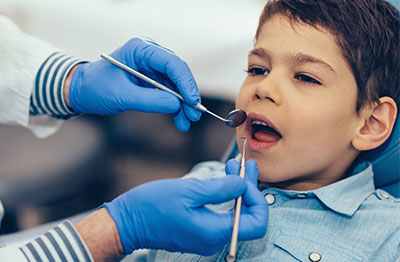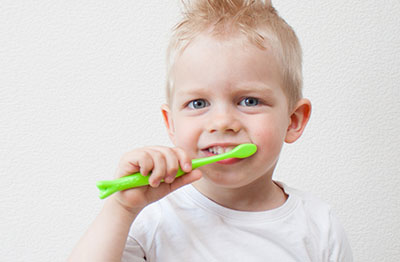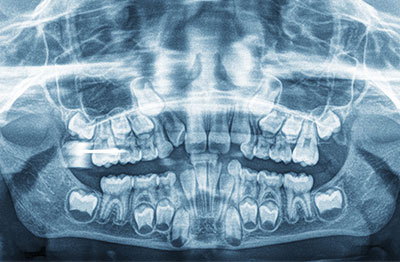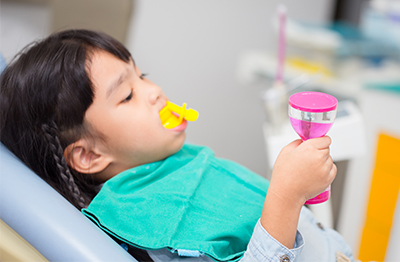
Your child's first visit to our office is very important with regard to establishing their oral health baseline. We will begin by carefully reviewing medical and dental histories and taking special note of all dental concerns, as well as any symptoms that your child may be experiencing.
We take pride in creating and maintaining beautiful and healthy smiles for our younger patients in an environment that is lighthearted and fun. We focus on establishing oral health habits that last a lifetime, with education and prevention as our primary tools.

Tooth decay is the most chronic childhood disease in our country. According to studies, children with poor oral health are more than three times as likely to miss school due to dental pain. While these statistics are alarming, the good news is that tooth decay is for the most part preventable. Scheduling regular checkups and cleanings for your child at the dentist is essential for maintaining their oral health. Beyond routine dental care, your dental care professional will help your child establish the best oral hygiene homecare regimen to help maintain a healthy smile for a lifetime. The dentist will also provide dietary guidance as to which foods can be harmful to your child's smile. As added protection against dental decay, periodic fluoride treatments to strengthen the enamel of your child's new teeth and the application of dental sealants when the permanent molars come into place are recommended.

The role of fluoride is especially important for children as it improves the quality of dental enamel in their developing teeth and makes their new teeth more resistant to decay. As part of your child’s preventive dental care program at our office, fluoride varnish is applied during their routine checkup appointments and if indicated at regular intervals between these visits.
Fluoride varnish is a topically applied product that is brushed onto all sides of your child’s teeth. It is a completely safe and painless procedure that takes just a couple of minutes from start to finish. Once applied and in contact with your child’s saliva the fluoride hardens. The fluoride component is now absorbed into the dental enamel and begins its job of strengthening the tooth.
Following the application of the fluoride varnish, your child does not have to wait to eat or drink. The only restriction is that foods are soft and not crunchy for the rest of the day. Brushing and flossing may be postponed for several hours.
While fluoride varnish can help prevent cavities and slow their progression, it is not a guarantee against dental decay. Optimal dental health for your child involves an excellent oral hygiene regimen at home, routine dental care and eating a healthy diet.

Tooth Colored Fillings
When tooth structure is eaten away or otherwised damaged by dental decay, cracks or fractures, it can often be repaired by means of the placement of a dental filling. While traditional fillings were typically composed of amalgam, a mixture of different metals, today’s fillings are frequently tooth-colored. These “white fillings” invisibly restore the form and function of the involved tooth so that it seamlessly blends in with the remaining tooth structure. Tooth colored fillings are made of the latest generation of composite resin materials in which filler particles are bound together when set by a hard matrix material. Strong and durable, tooth colored fillings are chemically bonded to fill and rebuild a tooth once the decayed or damaged tooth structure has been removed. First placed as a putty-like material, tooth colored fillings are carefully shaped to restore the contours of a healthy natural tooth and then cured (set) with a light wand. In addition to restoring teeth affected by damage or decay, composite resins can also be used to cosmetically change the size, color or shape of teeth with imperfections or minor alignment issues such as spacing.
Amalgam (silver) fillings, by request only
For many years, amalgam fillings, more commonly referred to as “silver fillings,” have represented the standard of care in rebuilding the form and function of a tooth that has been treated for dental decay. Composed of a combination of metals that include silver, tin, mercury and copper, dental amalgam has both the strength to withstand the heavy forces generated during chewing as well as the durability to retain its integrity over time. Although not as aesthetically pleasing as other types of restorations, amalgam fillings are less likely than some other types of fillings to break or wear down over time.
While dental amalgam contains elemental mercury, based on extensive studies and thorough reviews of scientific evidence, the American Dental Association (ADA), The Center for Disease Control and Prevention (CDC), the FDA, and the World Health Organization have all stated that amalgam is a safe and effective dental restoration that does not pose a risk to health. However, individuals with allergies or sensitivities to the metals in dental amalgam are advised to pursue other restorative options with their dentists.

Inside of every baby (deciduous) and permanent adult tooth is a central chamber that contains connective tissue, a nerve supply, and blood vessels. Collectively these core tissues, known as the dental pulp, help the tooth to grow and mature before it emerges into the mouth. Once your tooth is in place, the dental pulp provides nourishment, keeps the tooth vital, and alerts you of problems. Unfortunately, cavities and dental trauma can damage the dental pulp inside of a tooth. When one of these factors has involved the dental pulp of a primary or deciduous tooth and there is no evidence of an infection at the root of the tooth, a procedure known as a pulpotomy may be performed. The purpose of a pulpotomy on a “baby” tooth is to maintain it until its permanent successor tooth erupts. This is because deciduous teeth that are lost prematurely can result in space loss for the permanent tooth and other consequences. During a pulpotomy procedure, the exposed or affected pulp tissue within the crown of the deciduous tooth (the visible portion of the tooth) is carefully removed and a special medication to disinfect the area and calm the remaining nerve tissue is placed. Once the procedure is complete, the baby tooth is then restored. Depending on the amount of tooth structure remaining and how much time is left before the baby tooth is to fall out, the type of restoration is selected. Typically, the most effective restoration to seal the tooth and restore function, is a stainless steel crown.

Sometimes it is necessary to extract a tooth. This can happen for a variety of reasons. Extractions are commonly performed in cases where a deciduous “baby” tooth is reluctant to fall out, a severely broken down and non-restorable tooth is present, or “wisdom tooth” is poorly positioned and unable to fully erupt into place.
To reduce any anxiety and insure patient comfort whenever a tooth extraction is necessary, the procedure, the post surgical instructions, as well as any restorative follow-up care will be carefully and completely explained.

Sometimes, due to tooth decay or a traumatic injury, a child may lose a primary tooth early, before the permanent one underneath is ready to come into place. When this happens, the dentist will consider the best way to hold the space left by the baby tooth in order to maintain a clear path for the succeeding adult tooth. While not every situation where a baby tooth is lost early needs an intervention to maintain the space, many times a small dental appliance known as a space maintainer is required to make sure the permanent tooth does not become crowded out of the dental arch or impacted by shifting adjacent teeth.
Space maintainers are fixed or removable appliances that are designed to keep the integrity of the space left by the lost tooth. Simple and comfortable to wear, the type and design of your child’s space maintainer will be determined by our dentist. Once the permanent tooth begins to emerge, a space maintainer is no longer necessary.

Dental emergencies in children can arise for a number of reasons. Recognizing the fact that children have active lifestyles, means there is always a chance an accident involving a hit or blow to the mouth or teeth can occur. These traumatic injuries can happen at home, in the playground or on the playing field. Common injuries to the teeth and oral cavity seen in a pediatric dental office include everything from soft tissue lacerations of the lips, cheeks or tongue to chipped, fractured, dislodged or “knocked out” teeth. Equally frequent reasons for children to require urgent dental care are painful toothaches, dental infections, and mouth ulcerations. Whatever the dental emergency may be, prompt and effective care is required to alleviate a child’s discomfort and to prevent more serious consequences to their oral health and overall well-being.
Pediatric dentists are trained in all facets of dental care for children and are well equipped to handle a wide range of dental emergencies. They provide skilled and compassionate care, helping children to feel comfortable and safe while restoring their oral health and function.

Digital radiography utilizes computer technology and digital sensors for the acquisition, viewing, storage, and sharing of radiographic images. It offers several advantages over the older traditional film based methods of taking x-rays. The most significant of theses advantages is that digital radiography reduces a patient’s exposure to radiation. Other benefits are that images can be viewed instantly after being taken, can be seen simultaneously as needed by multiple practitioners, and can be easily shared with other offices. Digital x-rays are also safer for the environment as they do not require any chemicals or paper to develop.
An electronic pad, known as a sensor is used instead of film to acquire a digital image. After the image is taken, it goes directly into the patient’s file on the computer. Once it is stored on the computer, it can be easily viewed on a screen, shared, or printed out.

As part of your child’s dental prevention program, dental sealants are often recommended to protect their permanent back teeth from developing dental decay. In fact according to the American Dental Association, dental sealants reduce the risk of cavities in molars by approximately 80%.
While establishing a good oral hygiene regimen, maintaining proper toothbrushing habits, and avoiding sticky sweets are essential for the prevention of dental decay, children’s teeth often need more protection. The reason for this is that the deeply grooved chewing surfaces of the back permanent teeth can be difficult for a child to keep free of leftover food and cavity-causing bacteria. Moreover, young children do not always brush their teeth, as often or as thoroughly as they should, making them particularly vulnerable to dental decay.
Dental sealants afford additional protection from dental decay by providing a strong plastic-like protective coating for the chewing surfaces of a child’s permanent back teeth. They basically fill in the pits, fissures and grooves on these teeth to seal out harmful bacteria and food particles. Beyond preventing the development of cavities, sealants may also be useful over areas of incipient dental decay to stop further damage from occurring.
Applying dental sealants is a relatively quick and painless process. They are simply brushed on in a series of steps during a child’s dental visit and then cured (set) with a light wand. Sealants are strong and durable and can last for several years. The condition of your child’s dental sealants will be evaluated at each checkup and reapplied if the need arises.

One non-invasive approach to the treatment of dental decay in children that we provide at our office is the application of silver diamine fluoride 38%. Originally used exclusively as a treatment for sensitive teeth, this fluoride compound also offers an effective alternative to more conventional methods of care to stop the progression of dental decay. Since silver diamine fluoride 38% comes as a liquid solution, which is quick and painless to apply, it is an excellent option for children with cavities as well as for individuals of all ages who are unable to sit for longer dental procedures.
At the office of Turlock Children’s Dentistry, we treat children from infancy through adolescence and are especially sensitive to addressing the oral healthcare needs of children with special needs. As a specialized practice for Pediatric Dentistry, our doctors understand all aspects of child development, behavior management, skeletal, and dental growth as well as methods of anesthesia and sedation. With years of advanced training and experience in the field of pediatric dentistry, they are well equipped to address the dental needs of children of all ages. If your child has special needs and you’re searching for quality dental care in a warm, nurturing, and relaxing environment, our office welcomes the opportunity to help your child maintain optimal oral health.
It’s often the case that individuals with special needs are more susceptible to tooth decay and dental disease. Additionally, receiving a dental checkup as well as undergoing preventive and routine care can pose unique difficulties for children with chronic physical, developmental, behavioral, or emotional conditions.
As skilled and compassionate providers of care, our dental team understands how challenging it may be for a child with special needs to sit for and tolerate dental care and will carefully work with your child to ensure their comfort and earn their trust. By approaching care with expertise and kindness, our doctors strive to make each patient feel comfortable and every visit a positive experience.
With several years of advanced specialty training in pediatric dentistry, our doctors provide personalized dental services to treat children with conditions such as:
- Autism spectrum disorders
- Down syndrome
- Cerebral Palsy
- Neurological disorders
- Learning and developmental disabilities
If you’re seeking a pediatric and special needs dentist who can provide the highest quality of skilled and compassionate care for your children, give us a call today. We look forward to welcoming your family into ours!

